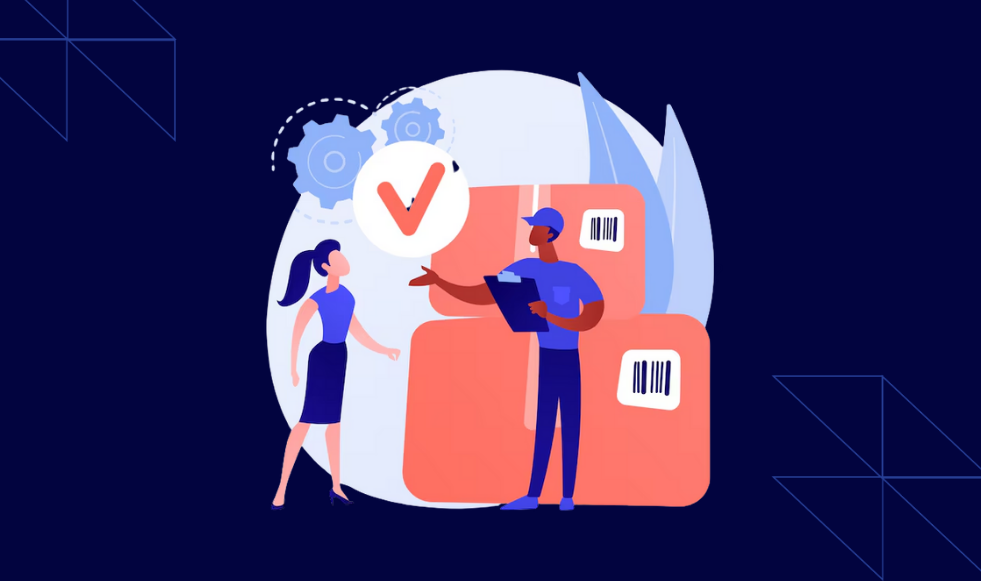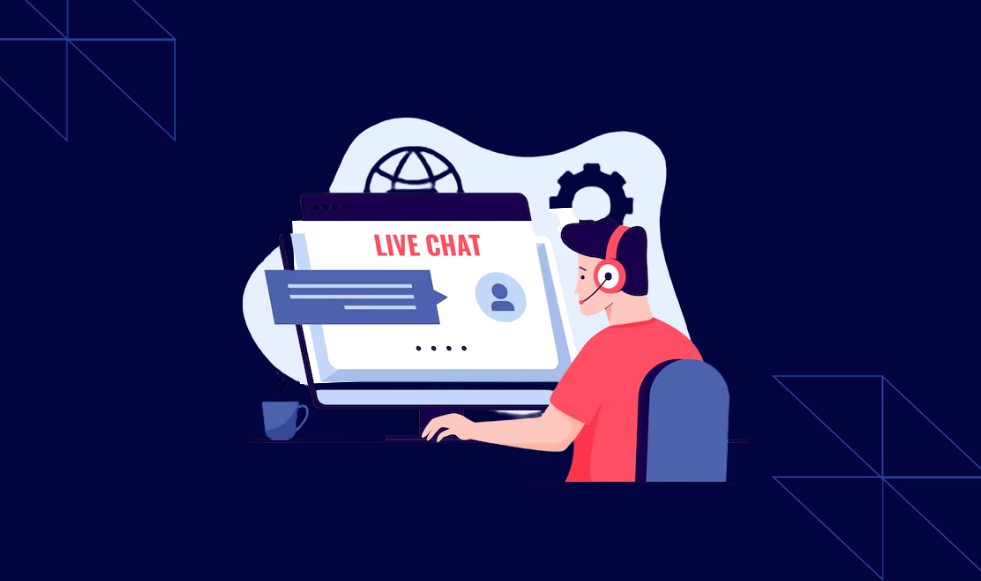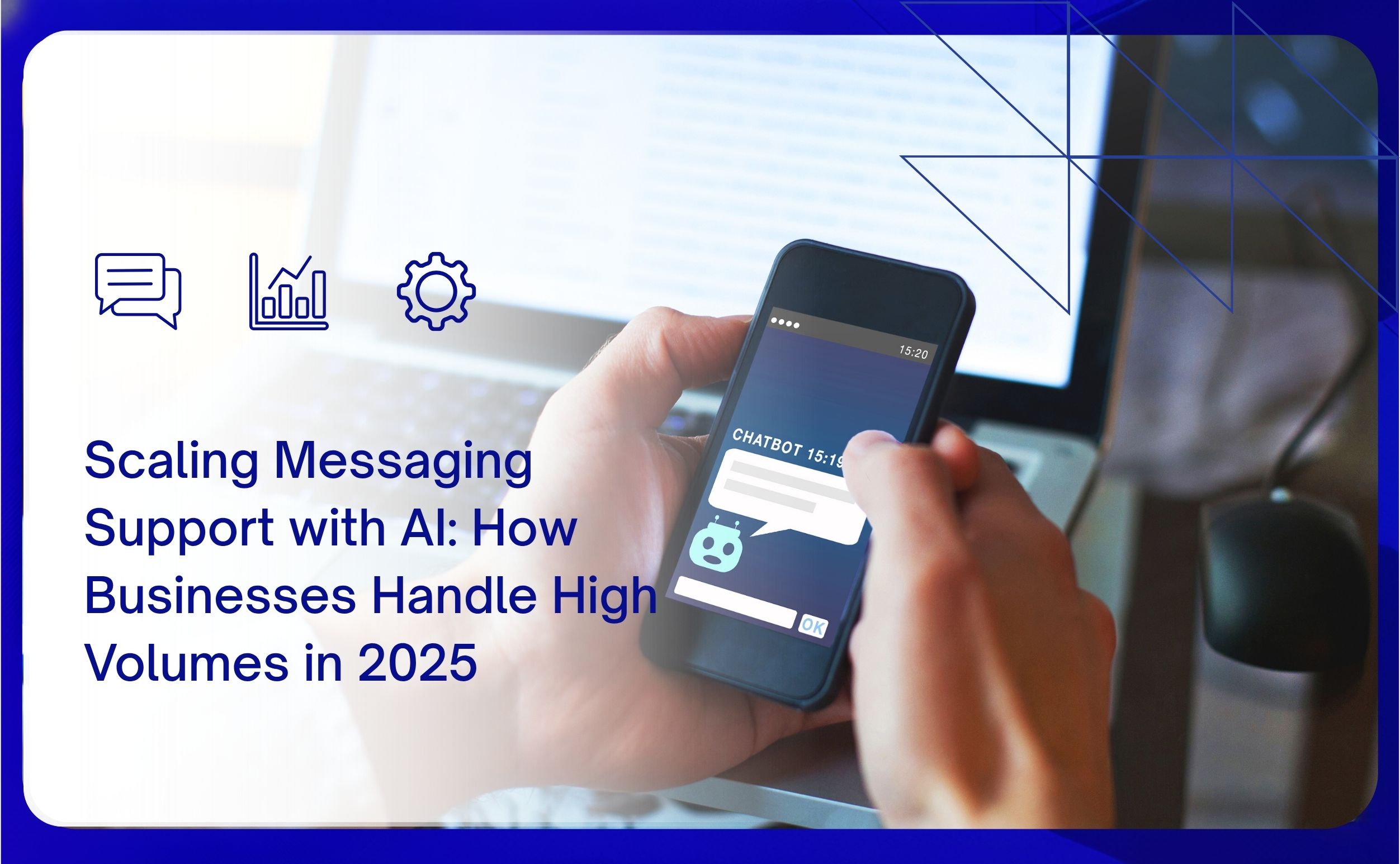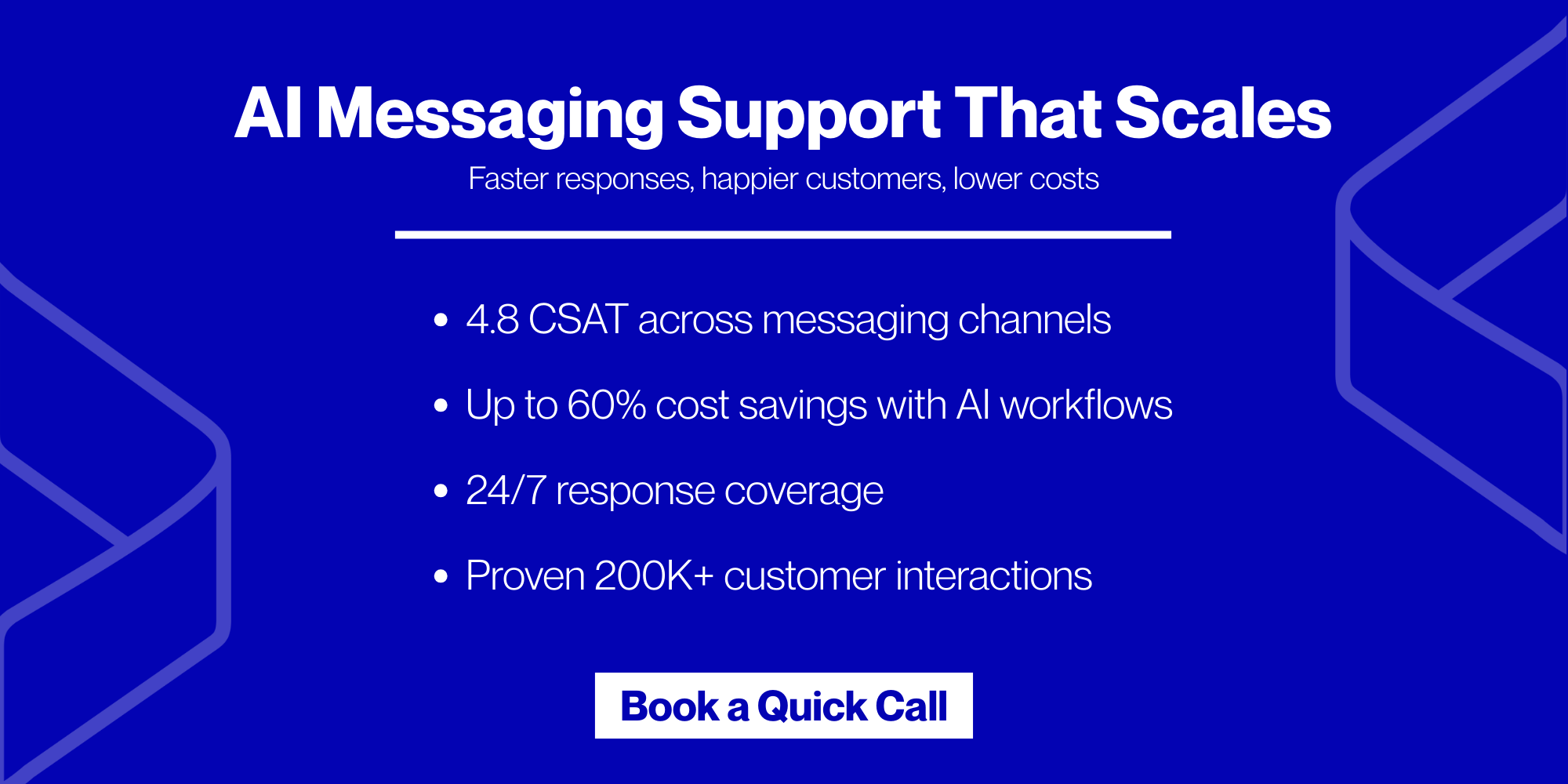In 2025, several businesses use “AI messaging automation” to manage a high number of customer conversations across multiple touchpoints. Such an automation is related to intelligent routing, sending proactive updates, and offering real-time agent assistance. These advancements also reduce routine workload and minimize customer waiting/ hold times.
In 2025, customer expectations are at an all-time high! Studies show that most customers want a response within 30 minutes. But only 50% businesses are meeting this strict expectation!
Want to remain in this category? Or want to become tech savvy and benefit from AI scalability? In 2025, chatbots will have grown into full AI agents that are expected to resolve up to 80% of routine questions (by 2029). Additionally, these agents are supported by:
- Virtual support systems that understand intent in seconds.
- Co-pilots that offer real-time agent assistance.
- Proactive alerts that cut tickets before they even exist.
Nowadays, several D2C companies and consumer brands operating in regions such as the US, UK, and Australia are using AI systems to manage more volume without draining budgets or burning out teams.
Want to learn how? Read this article to learn what AI messaging automation is and six ways businesses are using AI to handle high ticket volumes.
What is AI Messaging Automation?

AI messaging automation is the use of artificial intelligence to manage customer conversations across channels like chat, email, SMS, and social messaging. There is minimal human intervention required for routine cases. Instead of agents answering every question, AI systems handle common requests such as:
- Order status
- Billing queries
- Product returns
- Appointment reminders
Additionally, the system can also trigger proactive updates, like sending delivery alerts or payment reminders (based on customer data and events).
The benefits? For most D2C companies and consumer brands operating in multiple regions, like the US, UK, and Australia, this leads to:
- Faster responses with minimal resolution times
- Lower support costs
- Fewer repetitive tasks for staff
Gradually, you can achieve AI scalability by deploying more AI agents as your business expands. This allows you to handle a high ticket volume without adding more headcount.
6 Ways AI Is Helping Businesses Handle High Volumes in 2025!

Studies show that modern AI agents now resolve up to 45% of common and repetitive inquiries, such as password resets or order checks. Okay, but what are the real benefits of this automation? Businesses report up to 68% lower cost-per-interaction and a 27% increase in CSAT after adopting advanced AI in messaging support.
Want to learn how all this happens? These are six different ways the latest AI technologies are helping businesses deflect more tickets in 2025:
1. Modern AI Agents Do “Automated Chat Handling”
Today’s AI agents are the upgraded version of earlier chatbots. Instead of forcing customers to press numbers or wait for a person, these assistants can:
- Automate chat handling and have real conversations
- Search your knowledge base
- Know when to pass the issue to a human
For D2C companies and consumer brands generating $5M+ in revenue, such automation significantly reduces operational costs. Let’s see some real examples:
- A gaming company used Zendesk AI to manage common issues. They saved $1.3 million in one year by resolving 8,000 tickets without involving agents.
- Atidiv, a leading digital customer experience solutions provider, saved $1.3M for a U.S. tire retailer and $500K annually for a UK firm by managing over 230,000 support tickets.
Furthermore, research shows that mature systems can handle up to 80% of routine requests. This allows your staff to work only on complex cases.
The Cost Difference is Big!
AI conversations cost around $0.50–$0.70 each, while an agent costs about $19.50 per hour. Now, even if AI only deflects 20 to 30% of tickets out of 50,000 a year, the savings reach six figures.
Understand that AI scalability is high! Once stable, the same AI can handle chat, email, and social media without building new systems. Gradually, you can even expand with more languages and secure actions like refunds and custom workflows.
2. Virtual Agents Eliminate Frustrating Phone Trees!
Customers dislike old phone menus that ask them to “press 1” or “press 2.” Now, virtual customer support models replace these menus with systems that:
- Understand plain speech
- Detect intent
- Connect callers to the right agent on the first try
Large companies already use this to handle high ticket volumes! Let’s check out some real use cases:
| Use Case I | Use Case II |
|
|
Remember, in virtual support agents, usually, costs are billed per minute of use. Saving just 30 to 60 seconds per call can free hundreds of hours each quarter! For example:
- Say your business handles 10,000 calls in a quarter.
- If AI saves just 30 seconds per call, that’s 5,000 minutes saved.
- 5,000 minutes = over 83 hours freed up.
This promotes AI-driven workload management. Now, once the system is stable, you can enjoy AI scalability by expanding it to:
- Multi-language support
- Secure transactions (like payments)
- Automation that ties into back-end systems
3. Proactive Support Solves Problems Even Before Customers Ask
Traditional support waits for customers to complain, which creates backlogs. Now, AI flips this by offering “proactive support”. The AI systems try to reach out first by using product, logistics, and billing data.
For example,
- Say a delivery is delayed.
- Now, customers automatically get a “new ETA” alert.
- This avoids “where’s my order?” questions.
Studies show that sending such outage notices with live updates reduces call and ticket spikes by 20 to 25%.
The Business Advantage!
Many D2C companies and consumer brands (with 5+ employees) using proactive alerts no longer hire seasonal staff. That’s because issues get addressed before customers call.
Now, to achieve AI scalability, you can gradually expand the coverage to include:
- Billing errors
- Expiring cards
- Return reminders
Be aware that with AI and machine learning, these alerts have become more personalized. Nowadays, AI models use customer history + usage patterns to predict needs.
4. “Agent Copilots” Act Like Smart Assistants Inside the Helpdesk
Agent copilots are AI systems. They sit inside your support platform and guide your team in real time. Instead of agents manually searching for answers or drafting replies, the copilot:
- Suggests responses
- Summarizes long customer threads
- Pulls in the right knowledge article
The benefit? Your agents spend less time digging for information! On the screen, they can see:
- Ready-to-send first replies
- Quick summaries
- Related past cases
Okay, but what about the results? Teams often see around 14% productivity gains as minutes per ticket drop.
5. Automated Quality Checks for Scoring 100% Interactions
Traditional quality assurance only reviews a small fraction of customer conversations. As a result, most mistakes or coaching opportunities get missed!
Now, automated QA changes this. The AI models review 100% of chats, emails, and voice transcripts from day one. Based on this analysis, it scores interactions for:
- Tone
- Accuracy
- Compliance
- Overall customer experience
If we talk about a cost perspective, AI QA is offered as a fixed license or a usage-based model. It removes the need for manual sampling. The time saved allows your QA staff to shift focus from grading tickets to coaching agents.
What About the AI Scalability?
Once the system proves accurate, it can be scaled with multilingual scoring and real-time alerts. Also, dashboards can be customized to give VPs and directors of D2C companies a clear view of performance by agent, issue type, or product.
6. Send Customers to the “Right Agent” at the “Right Time”
Manually sorting tickets slows down response times! It often leads to mismatches between the issue and the agent’s skill. Now, intelligent routing systems (based on AI) assess urgency and match each request to the best available agent. This reduces wait times and prevents customer frustration.
Need evidence? Check some real-world examples:
- An IBM study found that AI-based routing improved agent productivity by 33%.
- One company saw average wait times drop to just 33 seconds with intent-based routing.
Now, if you’re thinking about costs, they are typically per seat or interaction. The return comes from fewer transfers, + faster resolutions, + saved agent time.
Is Getting Started Tough?
Nope! It does not require a complete system overhaul. You must perform these three steps:
- Map customer requests to agent skills.
- Connect the routing tool to your CRM and schedules.
- Add sentiment tags so upset customers are prioritized by senior staff.
Once live, the system can do predictive urgency scoring and load balancing across teams. It can also do more accurate intent recognition using natural language processing.
Finding AI Integration Tough? Outsource 100% of Your Customer Support to Atidiv in 2025!
Studies show that by 2026, as much as 80% of all customer support (including messaging) may be managed by autonomous AI agents. These systems allow businesses to handle higher ticket volumes by:
- Automating routine queries across chat, email, and voice
- Sending proactive alerts before customers raise issues
- Routing tickets to the right agents instantly
- Assisting support staff with AI copilots for faster responses
- Monitoring quality across every interaction
But it isn’t all rosy! AI adoption carries hidden costs, such as licensing fees, integration expenses, and ongoing training. Also, your business faces the risk of customer frustration if systems are poorly designed.
Want to cut through all this complexity? You can outsource 100% of your customer support to Atidiv, a leading customer experience solutions provider. We have 15+ years of experience and manage 70+ global clients. Our expert team delivers multiple services:
- Omnichannel messaging solutions
- Social media support
- Email answering services
- Inbound and outbound call center services, and more.
Our past clients have saved up to 60% compared to building everything in-house! Book a free consultation today to learn how we can help you.
AI Scalability FAQs
1. How much does AI customer support cost? Is it cheaper than hiring staff in 2025?
AI support is usually billed per interaction or per minute of use, while staff are paid hourly. A single AI chat costs about $0.50–$0.70, in comparison to $19.50 per agent hour. Now, even partial ticket deflection can bring six-figure savings annually.
2. Will my customers get frustrated talking to AI instead of people?
No! Modern AI uses:
- Speech recognition to understand spoken words
and
- Natural language processing (NLP) to interpret meaning and intent
This allows customers to speak or type in plain language and get accurate answers. Also, you can handle routine questions instantly and pass complex issues to humans without friction.
3. How quickly can I launch AI support in my business?
Most pilots can become live in a few weeks! Initially, you can start with 10 to 15 common questions, like billing, orders, or account access. Later, you can benefit from AI scalability and expand as performance proves reliable.
4. What will AI support look like by 2025?
By 2025, most mid-sized businesses and D2C companies are expected to use AI for messaging, voice, and routing. Please note that AI can’t replace your agents completely! Instead, it can only handle your high volumes of basic or routine tickets.
Furthermore, it is expected that by 2025, most companies will try to create the perfect balance of AI + human agents. By doing so, they can let their staff resolve only complex cases while AI bots handle repetitive messaging.
5. Are there hidden costs with AI support?
Yes. Beyond licenses, you need a budget for integration, training, and ongoing tuning of the system. Remember that poorly configured AI can also hurt customer satisfaction.
That’s why many D2C companies and consumer brands earning $5M+ revenue avoid these risks by outsourcing to leading customer experience solutions providers who already have the tools, people, and expertise in place. To learn how Atidiv operates, book a free consultation today!

